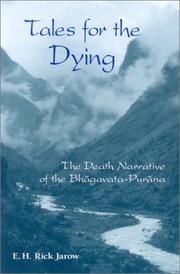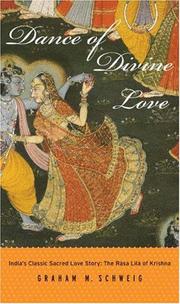| Listing 1 - 4 of 4 |
Sort by
|
Book
ISBN: 0231169019 0231169000 0231542348 9780231542340 9780231169004 9780231169011 Year: 2016 Publisher: New York Columbia University Press
Abstract | Keywords | Export | Availability | Bookmark
 Loading...
Loading...Choose an application
- Reference Manager
- EndNote
- RefWorks (Direct export to RefWorks)
Formalized by the tenth century, the expansive Bhagavata Purana resists easy categorization. While the narrative holds together as a coherent literary work, its language and expression compete with the best of Sanskrit poetry. The text's theological message focuses on devotion to Krishna or Vishnu, and its philosophical outlook is grounded in the classical traditions of Vedanta and Samkhya. No other Purana has inspired so much commentary, imitation, and derivation. The work has grown in vibrancy through centuries of performance, interpretation, worship, and debate and has guided the actions and meditations of elite intellectuals and everyday worshippers alike. This annotated translation and detailed analysis shows how one text can have such enduring appeal. Key selections from the Bhagavata Purana are faithfully translated, while all remaining sections of the Purana are concisely summarized, providing the reader with a continuous and comprehensive narrative. Detailed endnotes explain unfamiliar concepts and several essays elucidate the rich philosophical and religious debates found in the Sanskrit commentaries. Together with the multidisciplinary readings contained in the companion volume The Bhagavata Purana: Sacred Text and Living Tradition (Columbia, 2013), this book makes a central Hindu masterpiece more accessible to English-speaking audiences and more meaningful to scholars of Hindu literature, philosophy, and religion.
Puranas. --- Bhāgavata Purāṇa --- Śrīmad-Bhāgavata --- Bhāgavatapurāṇa --- Śrīmadbhāgavata --- Śrīmagbhāgavatam --- Shreemadbhagwat --- Śrīmadbhāgavatamahāpurāṇam Sātvatasaṃhitā --- Maharṣi Śrīvedavyāsapraṇītam Śrīmad Bhāgavatam --- Śrīpejāvaramaṭhīya-Śrīsubramaṇyamaṭhīyahastalikhitapustakānusāreṇa saṃśodhitaśrīvijayadhvajīyapāṭhānuguṇam Śrīmagbhāgavatam --- RELIGION / Hinduism / Sacred Writings.

ISBN: 0791487458 1417506814 9781417506811 0791456099 9780791456095 0791456102 9780791456101 9780791487457 Year: 2003 Publisher: Albany State University of New York Press
Abstract | Keywords | Export | Availability | Bookmark
 Loading...
Loading...Choose an application
- Reference Manager
- EndNote
- RefWorks (Direct export to RefWorks)
Tales for the Dying explores the centrality of death and dying in the narrative of the Bhāgavata-Purāna, India's great text of devotional theism, canonized as an integral part of the Vaisnava bhakti tradition. The text grapples with death through an imaginative meditation, one that works through the presence and power of narrative. The story of the Bhāgavata-Purāna is spoken to a king who is about to die, and it enables him to come to terms with his own passing. The work does not isolate dying as an issue; it treats it on many levels.This book discusses how images of dying in the Bhāgavata-Purāna relate to issues of language and love in the religious imagination of India. Drawing on insights from studies in myth, literary semiotics, and depth psychology, as well as from Indian commentarial and aesthetic traditions, the author examines the power of myth and narrative (storytelling or hari katha) and shows how a detailed awareness of the Puranic imagination may lead to a revisioning of some long-held presuppositions around Indian religious attitudes toward dying. By casting Vaisnava bhakti traditions and Puranic narrative in a fresh light, the mythic imagination of the Purānas takes its place on the stage of contemporary discourse on comparative mythology and literature.
Death --- Religious aspects --- Hinduism. --- Puranas. --- Bhāgavata Purāṇa --- Śrīmad-Bhāgavata --- Bhāgavatapurāṇa --- Śrīmadbhāgavata --- Śrīmagbhāgavatam --- Shreemadbhagwat --- Śrīmadbhāgavatamahāpurāṇam Sātvatasaṃhitā --- Maharṣi Śrīvedavyāsapraṇītam Śrīmad Bhāgavatam --- Śrīpejāvaramaṭhīya-Śrīsubramaṇyamaṭhīyahastalikhitapustakānusāreṇa saṃśodhitaśrīvijayadhvajīyapāṭhānuguṇam Śrīmagbhāgavatam --- Criticism, interpretation, etc.
Book
ISBN: 1350988413 0857739255 0857725742 9780857725745 9780857739254 9781784531997 1784531995 Year: 2016 Publisher: London
Abstract | Keywords | Export | Availability | Bookmark
 Loading...
Loading...Choose an application
- Reference Manager
- EndNote
- RefWorks (Direct export to RefWorks)
"The Bhagavata Purana is one of the most important, central and popular scriptures of Hinduism. A medieval Sanskrit text, its influence as a religious book has been comparable only to that of the great Hindu epics, the Ramayana and the Mahabharata. Ithamar Theodor here offers the first analysis for twenty years of the Bhagavata Purana (often called the Fifth Veda ) and its different layers of meaning. He addresses its lyrical meditations on the activities of Krishna (avatar of Lord Vishnu), the central place it affords to the doctrine of bhakti (religious devotion) and its treatment of older Vedic traditions of knowledge. At the same time he places this subtle, poetical book within the context of the wider Hindu scriptures and the other Puranas, including the similar but less grand and significant Vishnu Purana. The author argues that the Bhagavata Purana is a unique work which represents the meeting place of two great orthodox Hindu traditions, the Vedic-Upanishadic and the Aesthetic. As such, it is one of India s greatest theological treatises. This book illuminates its character and continuing significance."--
Puranas. --- Bhāgavata Purāṇa --- Śrīmad-Bhāgavata --- Bhāgavatapurāṇa --- Śrīmadbhāgavata --- Śrīmagbhāgavatam --- Shreemadbhagwat --- Śrīmadbhāgavatamahāpurāṇam Sātvatasaṃhitā --- Maharṣi Śrīvedavyāsapraṇītam Śrīmad Bhāgavatam --- Śrīpejāvaramaṭhīya-Śrīsubramaṇyamaṭhīyahastalikhitapustakānusāreṇa saṃśodhitaśrīvijayadhvajīyapāṭhānuguṇam Śrīmagbhāgavatam --- Criticism, interpretation, etc.

ISBN: 0691114463 9780691114460 0691190178 Year: 2005 Publisher: Princeton Princeton university press
Abstract | Keywords | Export | Availability | Bookmark
 Loading...
Loading...Choose an application
- Reference Manager
- EndNote
- RefWorks (Direct export to RefWorks)
Krishna (Hindu deity). --- Radha (Hindu deity). --- Rasa lila (Dance). --- Rādhā (Hindu deity). --- Rāsa līlā (Dance). --- Puranas. --- Criticism, interpretation, etc. --- Krishna (Hindu deity) --- Rādhā (Hindu deity) --- Rāsa līlā (Dance) --- 294.521.4 --- Rasa dance --- Dance --- 294.521.4 Godheden uit het Hindoeïsme: Brahma; Shiva; Vishnu; Krishna --- Godheden uit het Hindoeïsme: Brahma; Shiva; Vishnu; Krishna --- Bhāgavata Purāṇa --- Śrīmad-Bhāgavata --- Bhāgavatapurāṇa --- Śrīmadbhāgavata --- Śrīmagbhāgavatam --- Shreemadbhagwat --- Śrīmadbhāgavatamahāpurāṇam Sātvatasaṃhitā --- Maharṣi Śrīvedavyāsapraṇītam Śrīmad Bhāgavatam --- Śrīpejāvaramaṭhīya-Śrīsubramaṇyamaṭhīyahastalikhitapustakānusāreṇa saṃśodhitaśrīvijayadhvajīyapāṭhānuguṇam Śrīmagbhāgavatam
| Listing 1 - 4 of 4 |
Sort by
|

 Search
Search Feedback
Feedback About UniCat
About UniCat  Help
Help News
News